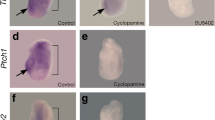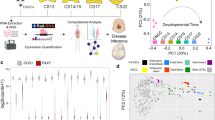Abstract
The 22q11 deletion syndrome (22q11DS; DiGeorge/velo-cardio-facial syndrome) primarily affects the structures comprising the pharyngeal arches and pouches resulting in arch artery, cardiac, parathyroid, thymus, palatal and craniofacial defects. Tbx1 haploinsufficiency is thought to account for the main structural anomalies observed in the 22q11DS. The Df1 deleted mouse provides a model for 22q11DS, the deletion reflecting Tbx1 haploinsufficiency in the context of the deletion of 21 adjacent genes. We examined the expression of genes in Df1 embryos at embryonic day (E) 10.5, a stage when the arch-artery phenotype is fully penetrant. Our aims were threefold, with our primary aim to identify differentially regulated genes. Second, we asked whether any of the genes hemizygous in Df1 were dosage compensated to wild type levels, and third we investigated whether genes immediately adjacent to the deletion were dysregulated secondary to a position effect. Utilisation of oligonulceotide arrays allowed us to achieve our aims with 9 out of 12 Df1 deleted genes passing the stringent statistical filtering applied. Several genes involved in vasculogenesis and cardiogenesis were validated by real time quantitative PCR (RTQPCR), including Connexin 45, a gene required for normal vascular development, and Dnajb9 a gene implicated in microvascular differentiation. There was no evidence of any dosage compensation of deleted genes, suggesting this phenomenon is rare, and no dysregulation of genes mapping immediately adjacent to the deletion was detected. However Crkl, another gene implicated in the 22q11DS phenotype, was found to be downregulated by microarray and RTQPCR.


Similar content being viewed by others
References
Amati F, Conti E, Novelli A, Bengala M, Diglio MC, Marino B, Giannotti A, Gabrielli O, Novelli G, Dallapiccola B (1999) Atypical deletions suggest five 22q11.2 critical regions related to the DiGeorge/velo-cardio-facial syndrome. Eur J Hum Genet 7:903–909
Ataliotis P, Ivins S, Latinkic B, Mohun TJ, Scambler PJ (2004) XTbx1 is a transcriptional activator involved in head and pharyngeal arch development in Xenopus laevis. Dev Dyn (in press)
Botta A, Amati F, Novelli G (2001) Causes of the phenotype-genotype dissociation in DiGeorge syndrome: clues from mouse models. Trends Genet 17:551–554
Bruneau BG, Nemer G, Schmitt JP, Charron F, Robitaille L, Caron S, Conner DA, Gessler M, Nemer M, Seidman CE, Seidman JG (2001) A murine model of Holt-Oram syndrome defines roles of the T-box transcription factor Tbx5 in cardiogenesis and disease. Cell 106:709–721
Cai DH, Brauer PR (2002) Synthetic matrix metalloproteinase inhibitor decreases early cardiac neural crest migration in chicken embryos. Dev Dyn 224:441–449
Chiang PW, Kurnit DM (2003) Study of dosage compensation in Drosophila. Genetics 165:1167–1181
Farrell M, Stadt H, Wallis K, Scambler PJ, Hixon RL, Wolfe R, Leatherbury L, Kirby M (1999) Persistent truncus arteriosus is associated with decreased expression of HIRA by cardiac neural crest cells in chick embryos. Circ Res 84:127–135
Guidi CJ, Veal TM, Jones SN, Imbalzano AN (2004) Transcriptional compensation for loss of an allele of the Ini1 tumor suppressor. J Biol Chem 279:4180–4185
Guris DL, Fantes J, Tara D, Druker BJ, Imamoto A (2001) Mice lacking the homologue of the human 22q11.2 gene CRKL phenocopy neurocristopathies of DiGeorge syndrome. Nat Genet 27:293–298
Hu T, Yamagishi H, Maeda J, McAnally J, Yamagishi C, Srivastava D (2004) Tbx1 regulates fibroblast growth factors in the anterior heart field through a reinforcing autoregulatory loop involving forkhead transcription factors. Development 131:5491–5502
Kleinjan DA, Seawright A, Schedl A, Quinlan RA, Danes S, van HV (2001) Aniridia-associated translocations, DNase hypersensitivity, sequence comparison and transgenic analysis redefine the functional domain of PAX6. Hum Mol Genet 10:2049–2059
Kruger O, Plum A, Kim JS, Winterhager E, Maxeiner S, Hallas G, Kirchhoff S, Traub O, Lamers WH, Willecke K (2000) Defective vascular development in connexin 45-deficient mice. Development 127:4179–4193
Kumai M, Nishii K, Nakamura K, Takeda N, Suzuki M, Shibata Y (2000) Loss of connexin45 causes a cushion defect in early cardiogenesis. Development 127:3501–3512
Li QY, Newbury-Ecob RA, Terrett JA, Wilson DI, Curtis ARJ, Yi CH, Gebuhr T, Bullen PJ, Robson SC, Strachan T, Bonnet D, Lyonnet S, Young ID, Raeburn A, Buckler AJ, Law DJ, Brook JD (1997) Holt-Oram syndrome is caused by mutations in TBX5, a member of the Brachyury (T) gene family. Nat Genet 15:21–29
Lindsay EA, Baldini A (2001) Recovery from arterial growth delay reduces penetrance of cardiovascular defects in mice deleted for the DiGeorge syndrome region. Hum Mol Genet 10:997–1002
Lindsay EA, Botta A, Jurecic V, Carattini-Rivera S, Cheah Y-C, Rosenblatt HM, Bradley A, Baldini A (1999) Congenital heart disease in mice deficient for the DiGeorge syndrome region. Nature 401:379–383
Lindsay EA, Vitelli F, Su H, Morishima M, Huynh T, Pramparo T, Jurecic V, Ogunrinu G, Sutherland HF, Scambler PJ, Bradley A, Baldini A (2001) Tbx1 haploinsufficiency identified by functional scanning of the DiGeorge syndrome region is the cause of aortic arch defects in mice. Nature 401:97–101
Livak KJ, Schmittgen TD (2001) Analysis of relative gene expression data using real-time quantitative PCR and the 2(-Delta Delta C(T)) Method. Methods 25:402–408
Novelli G, Amati F, Dallapiccola B (2000) Individual haploinsufficient loci and the complex phenotype of DiGeorge syndrome. Mol Med Today 6:10–11
Pfeifer D, Kist R, Dewar K, Devon K, Lander ES, Birren B, Korniszewski L, Back E, Scherer G (1999) Campomelic dysplasia translocation breakpoints are scattered over 1 Mb proximal to SOX9: evidence for an extended control region. Am J Hum Genet 65:111–124
Prols F, Mayer MP, Renner O, Czarnecki PG, Ast M, Gassler C, Wilting J, Kurz H, Christ B (2001) Upregulation of the cochaperone Mdg1 in endothelial cells is induced by stress and during in vitro angiogenesis. Exp Cell Res 269:42–53
Rekdal C, Sjottem E, Johansen T (2000) The nuclear factor SPBP contains different functional domains and stimulates the activity of various transcriptional activators. J Biol Chem 275:40288–40300
Saran NG, Pletcher MT, Natale JE, Cheng Y, Reeves RH (2003) Global disruption of the cerebellar transcriptome in a Down syndrome mouse model. Hum Mol Genet 12:2013–2019
Scambler (2003) Velocardiofacial/DiGeorge syndrome. In: Cooper D (ed) Nature encyclopedia of the human genome. Macmillan, London
Sock E, Rettig SD, Enderich J, Bosl MR, Tamm ER, Wegner M (2004) Gene targeting reveals a widespread role for the high-mobility-group transcription factor Sox11 in tissue remodeling. Mol Cell Biol 24:6635–6644
Taddei I, Morishima M, Huynh T, Lindsay EA (2001) Genetic factors are major determinants of phenotypic variability in a mouse model of the DiGeorge/del22q11 syndromes. Proc Natl Acad Sci USA 98:11428–11431
Trieu M, Ma A, Eng SR, Fedtsova N, Turner EE (2003) Direct autoregulation and gene dosage compensation by POU-domain transcription factor Brn3a. Development 130:111–121
Vitelli F, Morishima M, Taddei I, Lindsay EA, Baldini A (2002a) Tbx1 mutation causes multiple cardiovascular defects and disrupts neural crest and cranial nerve migratory pathways. Hum Mol Genet 11:915–922
Vitelli F, Taddei I, Morishima M, Meyers EN, Lindsay EA, Baldini A (2002b) A genetic link between Tbx1 and fibroblast growth factor signaling. Development 129:4605–4611
Wang Z, Cody JD, Leach RJ, O’Connell P (1999) Gene expression patterns in cell lines from patients with 18q- syndrome. Hum Genet 104:467–475
Xu H, Morishima M, Wylie JN, Schwartz RJ, Bruneau BG, Lindsay EA, Baldini A (2004) Tbx1 has a dual role in the morphogenesis of the cardiac outflow tract. Development 131:3217–3227
Acknowledgements
PJS would like to thank the British Heart Foundation and Wellcome Trust for generous support. The work was also funded by grants from National Institutes of Health, NHLBI (to A.B.) and from the American Heart Association (to E.A.L.)
Author information
Authors and Affiliations
Corresponding author
Rights and permissions
About this article
Cite this article
Prescott, K., Ivins, S., Hubank, M. et al. Microarray analysis of the Df1 mouse model of the 22q11 deletion syndrome. Hum Genet 116, 486–496 (2005). https://doi.org/10.1007/s00439-005-1274-3
Received:
Accepted:
Published:
Issue Date:
DOI: https://doi.org/10.1007/s00439-005-1274-3




